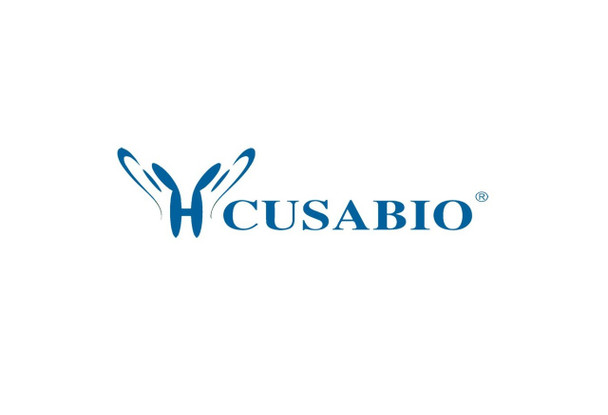Cusabio Human Recombinants
Recombinant Human Protein SSX2 (SSX2) | CSB-EP613674HU
- SKU:
- CSB-EP613674HU
- Availability:
- 13 - 23 Working Days
Description
Recombinant Human Protein SSX2 (SSX2) | CSB-EP613674HU | Cusabio
Alternative Name(s): Cancer/testis antigen 5.2 ;CT5.2Synovial sarcoma, X breakpoint 2Tumor antigen HOM-MEL-40
Gene Names: SSX2
Research Areas: Epigenetics and Nuclear Signaling
Organism: Homo sapiens (Human)
AA Sequence: MNGDDAFARRPTVGAQIPEKIQKAFDDIAKYFSKEEWEKMKASEKIFYVYMKRKYEAMTKLGFKATLPPFMCNKRAEDFQGNDLDNDPNRGNQVERPQMTFGRLQGISPKIMPKKPAEEGNDSEEVPEASGPQNDGKELCPPGKPTTSEKIHERSGPKRGEHAWTHRLRERKQLVIYEEISDPEEDDE
Source: E.coli
Tag Info: N-terminal 6xHis-SUMO-tagged
Expression Region: 1-188aa
Sequence Info: Full Length
MW: 37.6 kDa
Purity: Greater than 90% as determined by SDS-PAGE.
Relevance: Could act as a modulator of transcription.
Reference: The DNA sequence of the human X chromosome.Ross M.T., Grafham D.V., Coffey A.J., Scherer S., McLay K., Muzny D., Platzer M., Howell G.R., Burrows C., Bird C.P., Frankish A., Lovell F.L., Howe K.L., Ashurst J.L., Fulton R.S., Sudbrak R., Wen G., Jones M.C. , Hurles M.E., Andrews T.D., Scott C.E., Searle S., Ramser J., Whittaker A., Deadman R., Carter N.P., Hunt S.E., Chen R., Cree A., Gunaratne P., Havlak P., Hodgson A., Metzker M.L., Richards S., Scott G., Steffen D., Sodergren E., Wheeler D.A., Worley K.C., Ainscough R., Ambrose K.D., Ansari-Lari M.A., Aradhya S., Ashwell R.I., Babbage A.K., Bagguley C.L., Ballabio A., Banerjee R., Barker G.E., Barlow K.F., Barrett I.P., Bates K.N., Beare D.M., Beasley H., Beasley O., Beck A., Bethel G., Blechschmidt K., Brady N., Bray-Allen S., Bridgeman A.M., Brown A.J., Brown M.J., Bonnin D., Bruford E.A., Buhay C., Burch P., Burford D., Burgess J., Burrill W., Burton J., Bye J.M., Carder C., Carrel L., Chako J., Chapman J.C., Chavez D., Chen E., Chen G., Chen Y., Chen Z., Chinault C., Ciccodicola A., Clark S.Y., Clarke G., Clee C.M., Clegg S., Clerc-Blankenburg K., Clifford K., Cobley V., Cole C.G., Conquer J.S., Corby N., Connor R.E., David R., Davies J., Davis C., Davis J., Delgado O., Deshazo D., Dhami P., Ding Y., Dinh H., Dodsworth S., Draper H., Dugan-Rocha S., Dunham A., Dunn M., Durbin K.J., Dutta I., Eades T., Ellwood M., Emery-Cohen A., Errington H., Evans K.L., Faulkner L., Francis F., Frankland J., Fraser A.E., Galgoczy P., Gilbert J., Gill R., Gloeckner G., Gregory S.G., Gribble S., Griffiths C., Grocock R., Gu Y., Gwilliam R., Hamilton C., Hart E.A., Hawes A., Heath P.D., Heitmann K., Hennig S., Hernandez J., Hinzmann B., Ho S., Hoffs M., Howden P.J., Huckle E.J., Hume J., Hunt P.J., Hunt A.R., Isherwood J., Jacob L., Johnson D., Jones S., de Jong P.J., Joseph S.S., Keenan S., Kelly S., Kershaw J.K., Khan Z., Kioschis P., Klages S., Knights A.J., Kosiura A., Kovar-Smith C., Laird G.K., Langford C., Lawlor S., Leversha M., Lewis L., Liu W., Lloyd C., Lloyd D.M., Loulseged H., Loveland J.E., Lovell J.D., Lozado R., Lu J., Lyne R., Ma J., Maheshwari M., Matthews L.H., McDowall J., McLaren S., McMurray A., Meidl P., Meitinger T., Milne S., Miner G., Mistry S.L., Morgan M., Morris S., Mueller I., Mullikin J.C., Nguyen N., Nordsiek G., Nyakatura G., O'dell C.N., Okwuonu G., Palmer S., Pandian R., Parker D., Parrish J., Pasternak S., Patel D., Pearce A.V., Pearson D.M., Pelan S.E., Perez L., Porter K.M., Ramsey Y., Reichwald K., Rhodes S., Ridler K.A., Schlessinger D., Schueler M.G., Sehra H.K., Shaw-Smith C., Shen H., Sheridan E.M., Shownkeen R., Skuce C.D., Smith M.L., Sotheran E.C., Steingruber H.E., Steward C.A., Storey R., Swann R.M., Swarbreck D., Tabor P.E., Taudien S., Taylor T., Teague B., Thomas K., Thorpe A., Timms K., Tracey A., Trevanion S., Tromans A.C., d'Urso M., Verduzco D., Villasana D., Waldron L., Wall M., Wang Q., Warren J., Warry G.L., Wei X., West A., Whitehead S.L., Whiteley M.N., Wilkinson J.E., Willey D.L., Williams G., Williams L., Williamson A., Williamson H., Wilming L., Woodmansey R.L., Wray P.W., Yen J., Zhang J., Zhou J., Zoghbi H., Zorilla S., Buck D., Reinhardt R., Poustka A., Rosenthal A., Lehrach H., Meindl A., Minx P.J., Hillier L.W., Willard H.F., Wilson R.K., Waterston R.H., Rice C.M., Vaudin M., Coulson A., Nelson D.L., Weinstock G., Sulston J.E., Durbin R.M., Hubbard T., Gibbs R.A., Beck S., Rogers J., Bentley D.R.Nature 434:325-337(2005)
Storage: The shelf life is related to many factors, storage state, buffer ingredients, storage temperature and the stability of the protein itself. Generally, the shelf life of liquid form is 6 months at -20?/-80?. The shelf life of lyophilized form is 12 months at -20?/-80?.
Notes: Repeated freezing and thawing is not recommended. Store working aliquots at 4? for up to one week.
Function: Could act as a modulator of transcription.
Involvement in disease: A chromosomal aberration involving SSX2 may be a cause of synovial sarcoma. Translocation t(X;18)(p11.2;q11.2). The translocation is specifically found in more than 80% of synovial sarcoma. The fusion products SSXT-SSX1 or SSXT-SSX2 are probably responsible for transforming activity. Heterogeneity in the position of the breakpoint can occur (low frequency).
Subcellular Location: Nucleus
Protein Families: SSX family
Tissue Specificity: Expressed at high level in the testis. Expressed at low level in thyroid. Not detected in tonsil, colon, lung, spleen, prostate, kidney, striated and smooth muscles. Detected in rhabdomyosarcoma and fibrosarcoma cell lines. Not detected in mesenchymal and epithelial cell lines.
Paythway:
Form: Liquid or Lyophilized powder
Buffer: If the delivery form is liquid, the default storage buffer is Tris/PBS-based buffer, 5%-50% glycerol. If the delivery form is lyophilized powder, the buffer before lyophilization is Tris/PBS-based buffer, 6% Trehalose, pH 8.0.
Reconstitution: We recommend that this vial be briefly centrifuged prior to opening to bring the contents to the bottom. Please reconstitute protein in deionized sterile water to a concentration of 0.1-1.0 mg/mL.We recommend to add 5-50% of glycerol (final concentration) and aliquot for long-term storage at -20?/-80?. Our default final concentration of glycerol is 50%. Customers could use it as reference.
Uniprot ID: Q16385
HGNC Database Link: HGNC
UniGene Database Link: UniGene
KEGG Database Link: KEGG
STRING Database Link: STRING
OMIM Database Link: OMIM









